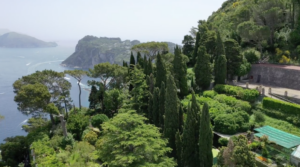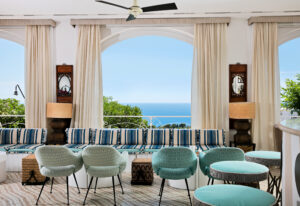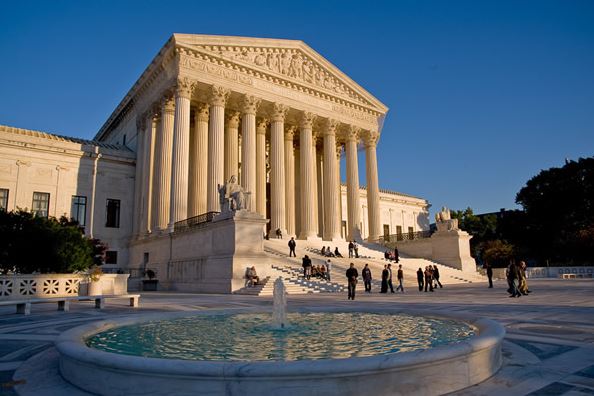
If the Amalfi Coast is Shangri-La for Americans traveling to Europe in the summer months, then the island of Capri is surely Bali Ha’i.
Measuring less than four square miles and reached in under an hour by fast ferry or hydrofoil from Naples, Amalfi or Sorrento, craggy Capri is a stunner, with tumbling cliffs; breathtaking paths and trails; ravishing, bougainvillea-covered whitewashed houses; glamorous shops; and, all around it, the jewel-like, sparkling Tyrrhenian Sea.
Post-pandemic, Capri – and do say it “CAH-pree,” the stress firmly on the first syllable – was quick to recover, the island humming again with a clutch of new and renovated hotels. One such is the Capri Tiberio Palace, where I was lucky enough to spend a few days toward the end of the summer season last year.
A fine period island house, formerly a slightly nondescript Marriott hotel now given a complete makeover by its new owners, this gorgeous property is the last word in dazzling design and immaculate good taste. A five-minute walk from Capri’s main square along the lovely Via Camerelle, the Capri Palace is not only small and utterly charming – the new owners reduced it from 70 rooms to just 40 – space, after all, being a key component of luxury – it is also located exactly where you want to be.

As they step off the ferry at the island’s port, Marina Grande, arriving guests are met by the hotel’s representative and ushered into one of the island’s open-top taxis for the thrilling three-minute ride up to Capri Town and a short walk to the hotel. (Capri Town’s narrow streets do not allow for regular traffic). Naturally, your bags are carried for you.
For a chap not usually short of words, I was rendered almost speechless as I took in the zingy tilework, the rows of curtained closets, the blowup Life magazine photograph of Sophia Loren (to remind guests of the age of real glamour) in my room and then opened the French doors to reveal my own private terrace with its heart-stoppingly lovely view. Ah, that divine terrace. I sat on it for hours during my stay, overlooking those whitewashed houses, the myrtle trees and cypresses, the bursting vines and the sparkling sea beyond – with nothing more than birdsong and the pleasing thwack of tennis balls being hit at the nearby Capri Tennis Club for company.
Milanese designer Giampiero Panepinto’s creation, which mimics a typical Caprese house, is nevertheless wonderfully eclectic. The hotel is a collection of beautiful paintings, prints, objects, curios and bibelots, strategically placed. Add in marble staircases with beautiful carved ironwork; lanterns; birdcages; glorious wall sconces; fabulous, handwoven, carpets; small trees in elegant planters and stone vases brimming over with pink and white carnations, and you still won’t get close to the magic of the Capri Palace.
In the spa, you get pounded to earthly bliss, while in the Jacky Bar, brimming with light by day, twinkly by night – and perfectly located at the front of the hotel so you can see people coming and going – you might get pummeled in another kind of way. Or you will feel that way, after two or three perfect Negronis.

In the Terrazza restaurant, staff in nautical whites with perfectly fitting navy blazers will serve you a lunch of superb antipasti and pasta or an exquisite five-course dinner on the terrace under the ink-black, starry Capri night. The bread alone is reason enough to visit, five different kinds, including Neapolitan casatiello, made from spelt – which is more like cake than regular bread – and moreish grissini, as thin as string. Among many heavenly dishes I enjoyed here, risotto of spaghettini – singing of the sea, with vongole (clams) and ricci (sea urchin) – and a scented risotto of Amalfi lemons were standouts.
Beyond the hotel, of course there is Capri itself to explore, with walks, hikes, activities and excursions aplenty. Anacapri, the island’s quieter town, is just a couple of miles away from Capri Town, 10 minutes by minibus. Then, there are the ruins of the Emperor Tiberius’s Villa Jovis, which two millennia ago was the site of unimaginable Roman debauchery. And renowned Swedish physician Axel Munthe’s Villa San Michele, with its bird’s-eye views and, of course, the iconic Faraglioni rocks and famous Blue Grotto.
But the point of Capri, insofar as doing nothing has any point at all, is to do none of these things, but simply to sit out on the Piazzetta, the small irregularly-shaped “square” that is the main meeting point of Capri Town, drink a caffè or cocktail or enjoy a gelato and watch the colorful crowd go by.
Let’s not forget shopping, though – possibly the chicest shopping in the Mediterranean, where for every Bulgari and Bottega Veneta boutique there is a (relatively) inexpensive independent costume jewelry, design or clothing store. For all its “beautiful people” and jet-set money, and believe me there are plenty of both, Capri is definitely egalitarian, with bling for all price points.

Time on Capri moves slowly and yet too fast. “‘Good-bye, Blue Grotto,’ sang the boatman, ‘come again soo-oon,’” F. Scott-Fitzgerald’s Nicole Diver reminisces in “Tender is the Night.”
Leaving Capri is hard. After three days of bliss, I decided that instead of a taxi, I would take the island’s famous funicular railway, which runs from the Piazzetta to Marina Grande to catch my ferry back to Naples. I mentioned it to the hotel concierge, who produced a ticket from his desk. “With our compliments,” he announced with a small flourish. The funicular ticket only costs a couple of euros – the best bargain on the not inexpensive Isle of Capri – and yet this simple gesture spoke volumes.
Then again, you’d expect nothing less from this classy hotel on this most seductive of islands.
For more, visit capritiberiopalace.it.






















